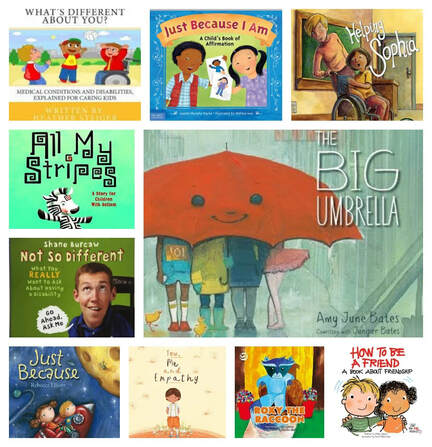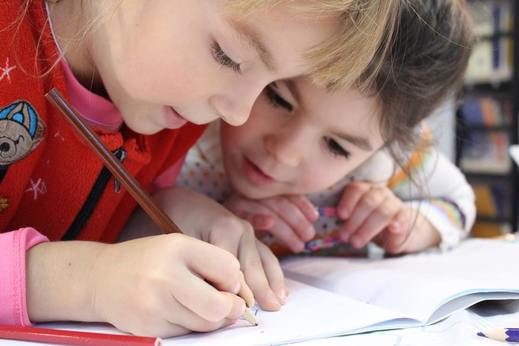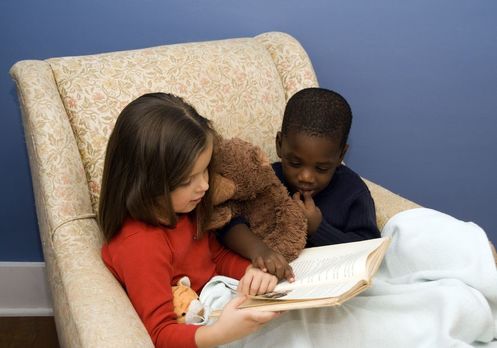|
1/24/2019 From the bookshelf: Titles that teach children about inclusion, disabilities and friendshipRead Now  Books can challenge perspectives. They introduce new ideas and clear up misconceptions. For adults and children alike, books open our worlds to new ways of thinking. Parents and teaches know all too well that teaching children inclusion, tolerance, how to love themselves and be a good friend to others is an important job. The good news is that many authors do too. Have you ever considered helping a child understand himself or see herself differently? Do the words come easily to you or are they difficult to find? Books can be such a gift in helping us find the right words to explain difficult concepts. Below are a few we found that may help you tell the story your child needs to hear, for his benefit as well as others’. Helping Sophia Sophia is a third grader who uses a wheelchair, and on a day when her usual helper isn’t in school, Sophia’s classmates step up to the plate to support her. The story informs enlightens children about children with disabilities while teaching caring and kindness. You, Me and Empathy Quinn is here to model the meaning of empathy in this charming story about understanding, compassion and kindness towards others. The book includes discussion questions and activities to promote this learned behavior in young readers. The Big Umbrella The School Library Journal describes The Big Umbrella as a “sweet extended metaphor uses an umbrella to demonstrate how kindness and inclusion work... A lovely addition to any library collection, for classroom use or for sharing at home.” The Big Umbrella is all about inclusivity and leaves opportunities for easy discussion when the story ends too. How to Be a Friend: A Book about Friendship Does your child know how to make friends? Teaching children the traits of being a good friend is the work of parents and teachers, but it’s not a skill readily taught in schools. The book’s author introduces children to the qualities that build good friendships, including loyalty, trust and honesty. Just Because In Just Because, Clemmie’s little brother expresses his love for his big sister, whom he adores though she can’t do many of the things most children can. He loves her no matter what and accepters her as he is. This charming read celebrates sibling friendship while lovingly unfolding Clemmie’s disabilities. Roxy the Raccoon: A Story to Help Children Learn about Disability and Inclusion Roxy has friends who love to do everything together, but sometimes that means making changes to plans and accommodating each other’s needs. This story from the forest teaches how to include friends with disabilities and why friends are happy to do so. Just Because I Am: A Child's Book of Affirmation No matter their abilities, all children deserve to value themselves and recognize their worth simply because they exist! This sweet book, full of affirmations, helps children understand their value, which doesn’t lie in what they do or what they look like. The read includes a discussion and activities section for parents, teachers and caregivers too. Not So Different: What You Really Want to Ask About Having a Disability He’s often asked what it’s like living with a disability, so Shane Burcaw answers them with humor and refreshing honesty in this fun book. More than any explanation of his abilities, he’s most effective in explaining how, in more ways than not, he’s just like everyone else. What's Different about You? This book offers a comprehensive look explaining medical conditions, impairments and disabilities in a kid-friendly and developmentally appropriate manner. It helps children understand such differences for more successful interactions at school, in public or even at home. (What’s Different About You? is touted as helpful in explaining topics to siblings of a child with a disability). All My Stripes: A Story for Children with Autism This Gold Medal/Mom’s Choice award-winning book shares the story of Zane, a zebra with autism who’s worried his differences will negatively impact his relationships with other students. As the book unfolds, Zane and his readers learn that autism is only one of the many qualities that make him unique, special and worth befriending. *** Congratulations on seeking new ways to teach your child how to interact with others in the most loving and kind ways! We invite you to research the above titles to determine reading level and whether the content meets your child’s specific needs. Together, we can help children understand how much they have in common and how their differences are worth treasuring too.  Pack comfort items for your child when they’re out and about. These may include a favorite toy, book, music or coloring supplies. Pack comfort items for your child when they’re out and about. These may include a favorite toy, book, music or coloring supplies. The holiday season can be a time of great joy, but for children with sensory issues, new schedules and once-a-year happenings can spell a-n-x-i-e-t-y. To reduce that possibility, Easterseals offers eight strategies to help parents and guardians and their sensory-sensitive children enjoy this festive season: 1. Prepare a schedule. A verbal, visual or handwritten schedule is imperative for busy days with sensory-sensitive children, particularly days that include multiple transitions and activities that may be unfamiliar to your child. Discussing events in advance and reviewing them several times can help a child understand what’s next, clarify expectations and reduce anxiety. Using social stories that include the timeline, activities and who’ll be attending can be comforting for children. Encourage questions and plan for any foreseen obstacles. 2. Be mindful of your child’s sensory needs. Try to avoid predictably stressful scenarios. For example, if your child does not like crowds, try shopping early in the morning or at night. If loud noises bother your child, try a smaller venue, or offer ear plugs or noise-reducing headphones. Determine a “break area” to serve as a safe escape as needed in case your child becomes overstimulated or overwhelmed. 3. Enlist your “village.” Have a family meeting and discuss holiday plans/activities that include your child. Discuss expectations with your family and problem solve potential obstacles in advance with them. 4. Prioritize sleep and meal schedules. Try not to deviate too much from your child’s daily schedule, with special attention to meal and nap/bed times. Keeping these predictable and scheduled as usual will pay off when it’s time to transition back to school, too. 5. Take proactive breaks. Locate a calm space/relax zone for each place you go and when possible, determine it in advance. Bring your child’s comfort toy(s) and identify a code word that your child can use to indicate they’re distressed. These often provide children with a sense of control and can reduce anxiety. Many meltdowns have been avoided by taking pro-active breaks. 6. Keep your child comfortable. Pack comfort items for your child when they’re out and about. These may include a favorite toy, book, music or coloring supplies. Bring extra items for your child to share with others to encourage socialization, too. If your child loves to play on your smartphone or another digital device, limit its use and only provide it during agreed-upon times (unless the device is used for communication with you). 7. Stay on track-food sensitivities: If your child has food allergies or sensitivities that may prevent them from enjoying holiday treats, bring alternatives enough to share. 8. Keep your holiday décor simple: The holidays are filled with twinkling lights, festive music and many new scents. To acclimate your child to changes in their home environment, for example, involve them in decorating. Allow them to help decide what and where holiday décor should be placed. Involving them in decision making gives a child a sense of control and can lead to some great “ah-ha” moments between you, too. Happy Holidays from Easterseals of Northeast Central Florida! We wish you all the love and joy the season brings.  Just as there’s no escaping the news coverage of Hurricane Florence this week, there’s no escaping a hurricane when it’s headed your way. Caring for children – including those with special needs -- during such an event can be doubly daunting. Faring well in a hurricane is all about preparedness, and resources from FEMA to the American Red Cross bring us tips on preparing emergency kits for such weather. (If you’ve not yet secured your hurricane preparedness kit, it’s time to do so. Florida’s hurricane season continues through November 30, and September is a peak month for hurricane activity.) For parents and caregivers of children with special needs, preparation takes on additional importance. Aside from physical preparations a family may need to undertake, the emotional and psychological trauma of uncertain and scary weather can be challenging for children. To help keep youngsters calm during storms and severe weather – once they are safely evacuated and/or secure – experts offer several ideas for families: 1. Demonstrate and encourage calm behavior. Calm parents and caregivers help children remain calm, too. Limit news coverage to only the necessary messages and monitor the media entering the child’s world. Non-stop meteorologist commentary can overwhelm anyone. 2. Explore the science of weather. Hurricanes and severe weather are scientific marvels. If your child is curious about what’s happening outside, gear up with some educational resources to help explain and entertain. Curriculum examples multiple grade levels are available via the National Education Association. 3. Keep routine as much as possible. Maintaining as much consistency in schedule as possible can help a child feel secure. If your child finds comfort in routine, keep the elements you can, such as eating lunch at a certain time or playing a favorite game after dinner. 4. Be honest and confident. If your child asks questions about the storm, answer them honestly; it’s okay to be brief. Confidently explain the measures the family has taken to ensure you’re all safe and you’re well prepared. Encouraging children’s questions will help them express their fears. 5. Encouraging hugging. From snuggling a favorite stuffed animal to sitting on daddy’s lap, cuddling up can help quell anxiety. 6. Give the kids a job. Feeling helpful can bring purpose to uncomfortable situations. Let your kids be helpers if possible. Ask them to collect candles, check the flashlight batteries or pack some snacks. Severe weather doesn’t have to be a severe bummer. Prepare your children and make the best of inevitable inconvenience by employing activities and mindsets that can bring the calm to any storm. Sources: Omaha.com, huffingtonpost.com, americanredcross.org, fema.gov. |
Details
Archives
May 2024
Categories
All
|

 RSS Feed
RSS Feed